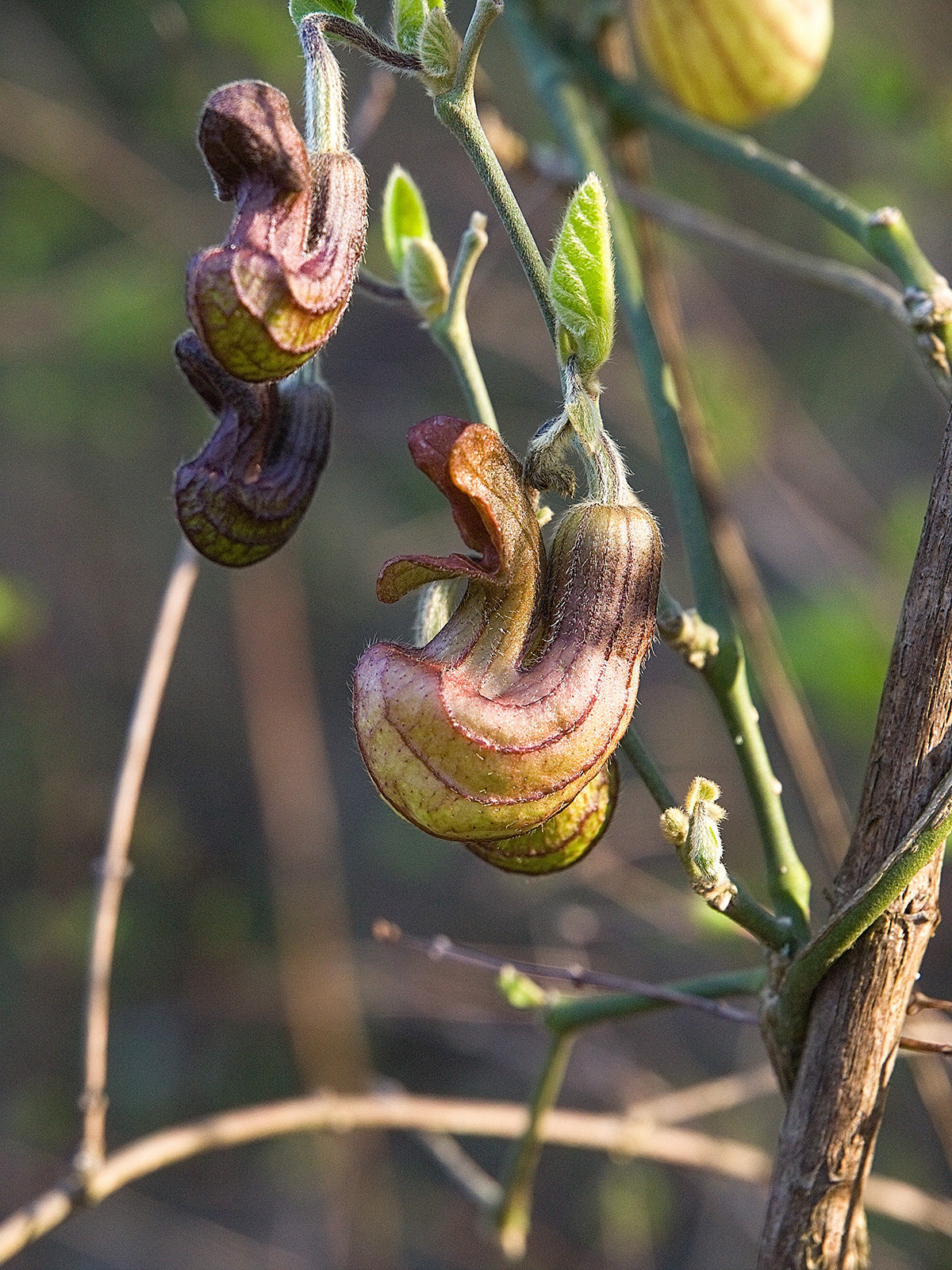
From late winter to early spring, Dutchman’s pipe, a perennial climbing vine, shoots out saxophone-shaped flowers that look like they were designed by Dr. Seuss—or, depending on your frame of reference, like smaller friendlier cousins of Audrey II, the mouthy plant in the film Little Shop of Horrors.
California Dutchman’s pipe, Aristolochia californica, is the only pipevine native to the state; it grows in northern and central California. The other 500 or so members of the Aristolochia genus also produce blossoms with wild-looking traits, including psychedelic spots, glam-rock fur, and a mellow lemon yellow hue.
Despite their varied appearance, all Aristolochia use the same sneaky strategy to facilitate reproduction. Attracted to the scent and colored petals, small fungus gnats become trapped in the flower. Different species in the Aristolochia genus seem to have different ways of trapping the creatures, exactly, but they often stay inside the plant for three or four days. During this period, the insects become covered in their captor’s pollen. They also import pollen from the last flower that held them hostage, transferring it from their bodies to the flower’s stigma, leading to fertilization and the beginning of seeds in the flower ovary.
Once the flower gets fertilized, the plant allows the trapped insect to escape, explains James Fordyce, a professor of ecology and evolutionary biology at the University of Tennessee, Knoxville, who has studied the California Dutchman’s pipe. They shrivel up and collapse, freeing the trapped insect. And the fertilization cycle begins anew.
While pipevine flowers take on the drudgery required to bring to life the next generation, ensnaring bugs considered by many as lowly pests, the plant’s leaves and vines host an insect with a decidedly more ethereal and elegant air: the pipevine swallowtail butterfly (Battus philenor), native to North America. With exquisitely hued black wings that appear iridescent blue when seen from just the right angle, this butterfly species depends completely on the California Dutchman’s pipe (and select other members of the Aristolochia genus) for successful reproduction.

Females lay eggs on the pipevine stem and growing tip, and the eggs hatch into caterpillars that gorge on the leaves. The leaves contain a toxin (as do all Aristolochia plants), but the caterpillars tolerate the poison and reach the pupa stage, when they molt into a chrysalis and later emerge as a butterfly. How does the caterpillar survive exposure to a toxin from a family of substances the National Cancer Institute says causes cancer?
Scientists don’t know, although the caterpillars tend to be good at tolerating a suite of noxious substances, Fordyce says. “Many sequestering insects, like pipevine swallowtails, store accumulated toxins in their exoskeleton.” (In the caterpillar phase, the toxin exists inside the animal as well.) In fact, these butterflies and caterpillars may use the plant’s poison to defend themselves against predators. “Beak marks on butterfly wings are not uncommon—the bird tastes a little bit of the wing and avoids the rest of the butterfly,” he adds. “The lucky ones survive.”
Curious to see the pipevine? Outside of its flowering season, you can easily miss California Dutchman’s pipe, as it blends right in with surrounding greenery. The plant is commonly found throughout Northern and Central California in moist areas—in woods and alongside creeks and streams, for example. The intrepid explorer’s first encounter with the plant might be to inadvertently trample it, since it’s often planted as ground cover. You might also spot it wound around tree branches; vines can grow more than 20 feet long. When out in the wild, look for the plant’s heart-shaped leaves, similar to a miniature taro leaf. But if time is short, head straight to the Regional Parks Botanic Garden in Tilden Regional Park, where a hardy stand grows alongside a running stream not far from the garden’s entrance.
If you want to cultivate a population of pipevine swallowtails in your own neighborhood, be patient. It takes a few years for California Dutchman’s pipes to establish themselves, but when they are grown, and if there are enough of them, the butterflies will come.




